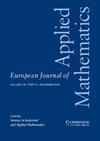Analysis and numerical simulations of travelling waves due to plant–soil negative feedback
IF 1.1
4区 数学
Q1 MATHEMATICS, APPLIED
引用次数: 0
Abstract
In this work, we carry out an analytical and numerical investigation of travelling waves representing arced vegetation patterns on sloped terrains. These patterns are reported to appear also in ecosystems which are not water deprived; therefore, we study the hypothesis that their appearance is due to plant–soil negative feedback, namely due to biomass-(auto)toxicity interactions. To this aim, we introduce a reaction-diffusion-advection model describing the dynamics of vegetation biomass and toxicity which includes the effect of sloped terrains on the spatial distribution of these variables. Our analytical investigation shows the absence of Turing patterns, whereas travelling waves (moving uphill in the slope direction) emerge. Investigating the corresponding dispersion relation, we provide an analytic expression for the asymptotic speed of the wave. Numerical simulations not only just confirm this analytical quantity but also reveal the impact of toxicity on the structure of the emerging travelling pattern. Our analysis represents a further step in understanding the mechanisms behind relevant plants‘ spatial distributions observed in real life. In particular, since vegetation patterns (both stationary and transient) are known to play a crucial role in determining the underlying ecosystems’ resilience, the framework presented here allows us to better understand the emergence of such structures to a larger variety of ecological scenarios and hence improve the relative strategies to ensure the ecosystems’ resilience.植物-土壤负反馈引起的行波分析与数值模拟
在这项工作中,我们对代表坡地上弧形植被模式的行波进行了分析和数值研究。据报道,这些图案也出现在不缺水的生态系统中;因此,我们研究了它们的出现是由于植物-土壤负反馈,即生物量-(自)毒性相互作用造成的这一假设。为此,我们引入了一个描述植被生物量和毒性动态的反应-扩散-对流模型,其中包括倾斜地形对这些变量空间分布的影响。我们的分析研究表明,没有图灵模式,但出现了行波(沿斜坡方向上坡)。通过研究相应的频散关系,我们给出了波的渐近速度的解析表达式。数值模拟不仅证实了这一分析量,还揭示了毒性对新出现的游波模式结构的影响。我们的分析进一步加深了对现实生活中观察到的相关植物空间分布背后机制的理解。特别是,由于植被模式(包括静态和瞬态模式)在决定生态系统的恢复能力方面起着至关重要的作用,因此本文提出的框架使我们能够更好地理解这种结构在更多生态情景中的出现,从而改进相关策略,确保生态系统的恢复能力。
本文章由计算机程序翻译,如有差异,请以英文原文为准。
求助全文
约1分钟内获得全文
求助全文
来源期刊
CiteScore
4.70
自引率
0.00%
发文量
31
审稿时长
>12 weeks
期刊介绍:
Since 2008 EJAM surveys have been expanded to cover Applied and Industrial Mathematics. Coverage of the journal has been strengthened in probabilistic applications, while still focusing on those areas of applied mathematics inspired by real-world applications, and at the same time fostering the development of theoretical methods with a broad range of applicability. Survey papers contain reviews of emerging areas of mathematics, either in core areas or with relevance to users in industry and other disciplines. Research papers may be in any area of applied mathematics, with special emphasis on new mathematical ideas, relevant to modelling and analysis in modern science and technology, and the development of interesting mathematical methods of wide applicability.

 求助内容:
求助内容: 应助结果提醒方式:
应助结果提醒方式:


